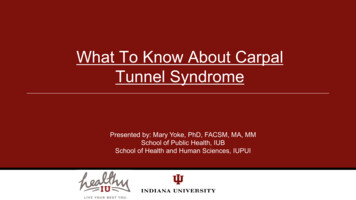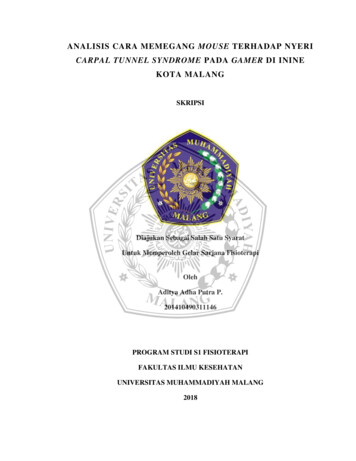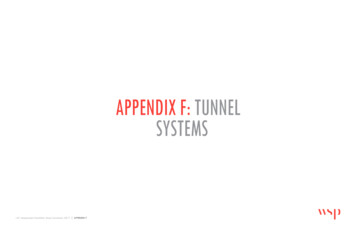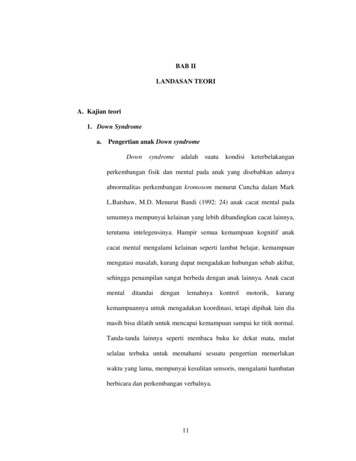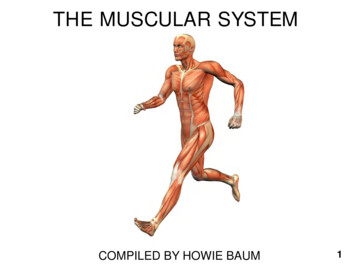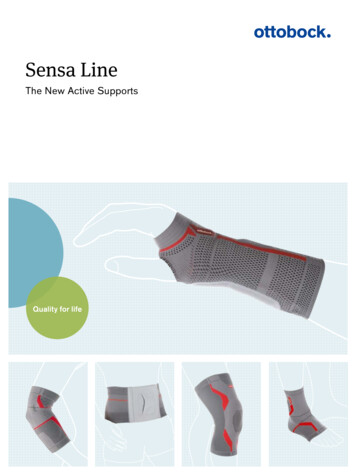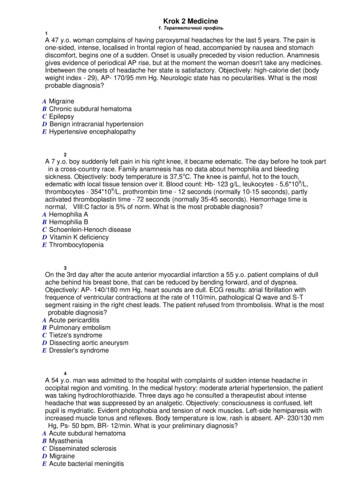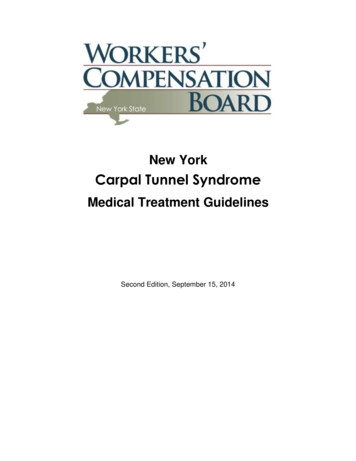
Transcription
New YorkCarpal Tunnel SyndromeMedical Treatment GuidelinesSecond Edition, September 15, 2014
New York State Workers’ Compensation BoardNew York Carpal Tunnel Syndrome Medical Treatment GuidelinesTABLE OF CONTENTSGENERAL GUIDELINE PRINCIPLES . 1INTRODUCTION . 8HISTORY TAKING AND PHYSICAL EXAMINATION . 8Second Edition, September 15, 2014i
New York State Workers’ Compensation BoardNew York Carpal Tunnel Syndrome Medical Treatment GuidelinesMAKING THE DIAGNOSIS . 12NON-OPERATIVE TREATMENT PROCEDURES . 17SURGERY . 26Second Edition, September 15, 2014ii
New York State Workers’ Compensation BoardNew York Carpal Tunnel Syndrome Medical Treatment GuidelinesAPPENDIX A:Diagnosis Reference Tables . 31INDEX. 37REFERENCES . 38Second Edition, September 15, 2014iii
New York State Workers’ Compensation BoardNew York Carpal Tunnel Syndrome Medical Treatment GuidelinesGENERAL GUIDELINE PRINCIPLESThe principles summarized in this section are key to the intended application of theNew York State Medical Treatment Guidelines (MTG).Medical CareMEDICAL CAREMedical care and treatment required as a result of a work-related injuryshould be focused on restoring functional ability required to meet thepatient’s daily and work activities and return to work, while striving to restorethe patient’s health to its pre-injury status in so far as is feasible.RENDERING OF MEDICAL SERVICESAny medical provider rendering services to a workers compensation patientmust utilize the Treatment Guidelines as provided for with respect to all workrelated injuries and/or illnesses.POSITIVE PATIENT RESPONSEPositive results are defined primarily as functional gains which can beobjectively measured. Objective functional gains include, but are not limitedto, positional tolerances, range of motion, strength, endurance, activities ofdaily living (ADL), cognition, psychological behavior, and efficiency/velocitymeasures which can be quantified. Subjective reports of pain and functionshould be considered and given relative weight when the pain has anatomicand physiologic correlation.RE-EVALUATE TREATMENTIf a given treatment or modality is not producing positive results, the providershould either modify or discontinue the treatment regime. The providershould evaluate the efficacy of the treatment or modality 2 to 3 weeks after theinitial visit and 3 to 4 weeks thereafter. Recognizing that treatment failure isat times attributable to an incorrect diagnosis should prompt the clinician toreconsider the diagnosis in the event of an unexpected poor response to anotherwise rational intervention.Second Edition, September 15, 20141
New York State Workers’ Compensation BoardNew York Carpal Tunnel Syndrome Medical Treatment GuidelinesEducationEDUCATIONEducation of the patient and family, as well as the employer, insurer, policymakers and the community should be a primary emphasis in the treatment ofwork-related injury or illness. Practitioners should develop and implementeffective educational strategies and skills. An education-based paradigmshould always start with communication providing reassuring information tothe patient. No treatment plan is complete without addressing issues ofindividual and/or group patient education as a means of facilitating selfmanagement of symptoms and prevention of future injury.Time FramesDIAGNOSTIC TIME FRAMESDiagnostic time frames for conducting diagnostic testing commence on thedate of injury. Clinical judgment may substantiate the need to accelerate ordecelerate the time frames discussed in this document.TREATMENT TIME FRAMESTreatment time frames for specific interventions commence once treatmentshave been initiated, not on the date of injury. Obviously, duration may beimpacted by disease process and severity, patient compliance, as well asavailability of services. Clinical judgment may substantiate the need toaccelerate or decelerate the time frames discussed in this document.DELAYED RECOVERYFor those patients who are failing to make expected progress 6-12 weeks afteran injury, reexamination in order to confirm the accuracy of the diagnosis andre-evaluation of the treatment program should be performed. Assessment forpotential barriers to recovery (yellow flags/psychological issues) should beongoing throughout the care of the patient. However, at 6-12 weeks, alternatetreatment programs, including formal psychological or psychosocialevaluation, should be considered. Referrals to mental health providers (e.g.,psychology/psychiatry) for the evaluation and management of delayedrecovery do not indicate or require the establishment of a psychiatric orpsychological condition. The evaluation and management of delayed recoverydoes not require the establishment of a psychiatric or psychological claim.Second Edition, September 15, 20142
New York State Workers’ Compensation BoardNew York Carpal Tunnel Syndrome Medical Treatment GuidelinesTreatment ApproachesACTIVE INTERVENTIONSActive interventions emphasizing patient responsibility, such as therapeuticexercise and/or functional treatment, are generally emphasized over passivemodalities, especially as treatment progresses. Generally, passive andpalliative interventions are viewed as a means to facilitate progress in anactive rehabilitation program with concomitant attainment of objectivefunctional gains.ACTIVE THERAPEUTIC EXERCISE PROGRAMActive therapeutic exercise program goals should incorporate patientstrength, endurance, flexibility, range of motion, sensory integration,coordination, and education as clinically indicated. This includes functionalapplication in vocational or community settings.DIAGNOSTIC IMAGING AND TESTING PROCEDURESClinical information obtained by history taking and physical examinationshould be the basis for selection and interpretation of imaging procedureresults. All diagnostic procedures have variable specificity and sensitivity forvarious diagnoses.When a diagnostic procedure, in conjunction with clinical information,provides sufficient information to establish an accurate diagnosis, a seconddiagnostic procedure will be redundant if it is performed only for diagnosticpurposes. At the same time, a subsequent diagnostic procedure (that may bea repeat of the same procedure, when the rehabilitation physician, radiologistor surgeon documents the study was of inadequate quality to make adiagnosis) can be a complementary diagnostic procedure if the first orpreceding procedures, in conjunction with clinical information, cannotprovide an accurate diagnosis, and is permissible under the MTG.It is recognized that repeat imaging studies and other tests may be warrantedby the clinical course and to follow the progress of treatment in some cases. Itmay be of value to repeat diagnostic procedures (e.g. imaging studies) duringthe course of care to reassess or stage the pathology when there is progressionof symptoms or findings, prior to surgical interventions and therapeuticinjections when warranted, and post-operatively to follow the healing process.Regarding CT examinations, it must be recognized that repeat proceduresresult in an increase in cumulative radiation dose and associated risks.Second Edition, September 15, 20143
New York State Workers’ Compensation BoardNew York Carpal Tunnel Syndrome Medical Treatment GuidelinesSURGICAL INTERVENTIONSContemplation of surgery should be within the context of expected functionaloutcome. The concept of "cure" with respect to surgical treatment by itself isgenerally a misnomer. All operative interventions must be based uponpositive correlation of clinical findings, clinical course and imaging and otherdiagnostic tests. A comprehensive assimilation of these factors must lead to aspecific diagnosis with positive identification of pathologic condition(s). Forsurgery to be performed to treat pain, there must be clear correlation betweenthe pain symptoms and objective evidence of its cause. In all cases, shareddecision making with the patient is advised. The patient should be given theopportunity to understand the pros and cons of surgery, potential forrehabilitation as an alternative where applicable, and evidence-basedoutcomes, and specific surgical experience.PRE-AUTHORIZATIONAll diagnostic imaging, testing procedures, non-surgical and surgicaltherapeutic procedures within the criteria of the Medical TreatmentGuidelines and based on a correct application of the Medical TreatmentGuidelines are considered authorized, with the exception of the followingprocedures: Lumbar Fusion, Artificial Disc Replacements, Vertebroplasty,Kyphoplasty, Electrical Bone Growth Stimulators, Spinal Cord Stimulators,Intrathecal Drug Delivery (Pain Pumps), Osteochondral Autograft, AutologousChondrocyte Implantation, Meniscal Allograft Transplantation and KneeArthroplasty (Total or Partial Knee Joint Replacement). These are notincluded on the list of pre-authorized procedures. Providers who want toperform one of these procedures must request pre-authorization from thecarrier before performing the procedure.Second or subsequent procedures (the repeat performance of a surgicalprocedure due to failure of, or incomplete success from the same surgicalprocedure performed earlier, if the Medical Treatment Guidelines do notspecifically address multiple procedures) also require SOCIAL EVALUATIONSIn select patients, diagnostic testing procedures may be useful when there is adiscrepancy between diagnosis, signs, symptoms, clinical concerns orfunctional recovery. Psychological testing should provide differentiationbetween pre-existing depression versus injury-caused depression, as well aspost-traumatic stress disorder, and other psychosocial issues that may includework or non-work-related issues when such conditions are identified in thepatient.Second Edition, September 15, 20144
New York State Workers’ Compensation BoardNew York Carpal Tunnel Syndrome Medical Treatment GuidelinesFor those patients who fail to make expected progress 6-12 weeks after aninjury and whose subjective symptoms do not correlate with objective signsand tests, reexamination in order to confirm the accuracy of the diagnosisshould be made. Formal psychological or psychosocial evaluation may beconsidered.A professional fluent in the primary language of the patient is stronglypreferred. When such a provider is not available, services of a professionallanguage interpreter must be provided.Frequency: One time visit for evaluation. If psychometric testing is indicatedby findings in the initial evaluation, time for such testing should not exceed anadditional two hours of professional time.PERSONALITY/PSYCHOLOGICAL/PSYCHOSOCIAL INTERVENTIONFollowing psychosocial evaluation, when intervention is recommended, suchintervention should be implemented as soon as possible. This can be usedalone or in conjunction with other treatment modalities. Time to produce effect: 2 to 8 weeks. Optimum duration: 6 weeks to 3 months. Maximum duration: 3 to 6 months. Counseling is not intendedto delay but to enhance functional recovery. For selectpatients, longer supervision may be required, and if furthercounseling is indicated, documentation of the nature of thepsychological factors, as well as projecting a realistic functionalprognosis, should be provided by the authorized treatingpractitioner every 4 to 6 weeks during treatment.Return to WorkFUNCTIONAL CAPACITY EVALUATION (FCE)Functional capacity evaluation is a comprehensive or more restrictedevaluation of the various aspects of function as they relate to the patient’sability to return to work. Areas such as endurance, lifting (dynamic andstatic), postural tolerance, specific range-of-motion, coordination andstrength, worker habits, employability, as well as psychosocial, cognitive, andsensory perceptual aspects of competitive employment may be evaluated.Components of this evaluation may include: (a) musculoskeletal screen; (b)cardiovascular profile/aerobic capacity; (c) coordination; (d) lift/carryinganalysis; (e) job-specific activity tolerance; (f) maximum voluntary effort; (g)pain assessment/psychological screening; (h) non-material and materialhandling activities; (i) cognitive; (j) visual; and (k) sensory perceptual factors.Second Edition, September 15, 20145
New York State Workers’ Compensation BoardNew York Carpal Tunnel Syndrome Medical Treatment GuidelinesIn most cases, the question of whether a patient can return to work can beanswered without an FCE.When an FCE is being used to determine return to a specific job site, thetreating physician is responsible for understanding and considering the jobduties. FCEs cannot be used in isolation to determine work restrictions. Theauthorized treating physician must interpret the FCE in light of the individualpatient's presentation and medical and personal perceptions.FCEs should not be used as the sole criteria to diagnose malingering.An FCE may be considered at time of MMI, following reasonable priorattempts to return to full duty throughout course of treatment, when thetreating physician is unable to make a clear determination on work status oncase closure.RETURN TO WORKFor purposes of these guidelines, return to work is defined as any work orduty that the patient is able to perform safely. It may not be the patient’sregular work. Ascertaining a return to work status is part of medical care, andshould be included in the treatment and rehabilitation plan. It is normallyaddressed at every outpatient visit. A description of the patient’s status andtask limitations is part of any treatment plan and should provide the basis forrestriction of work activities when warranted. Early return to work should bea prime goal in treating occupational injuries. The emphasis within theseguidelines is to move patients along a continuum of care and return to work,since the prognosis of returning an injured worker to work dropsprogressively the longer the worker has been out of work.JOB SITE EVALUATIONThe treating physician may communicate with the employer or the employer’sdesignee, either in person or by telephone, to obtain information regardingthe demands of the patient’s pre-injury job, including a description of theexertional demands of the job, the need for repetitive activities, load lifting,static or awkward postures, or any other factors that would pose a risk of reinjury or impedance of convalescence. When returning to work at thepatient’s previous job task/setting is not feasible, given the clinicallydetermined restrictions on the patient’s activities, inquiry should also bemade about modified duty work settings, and a similar set of questions shouldbe posed by the physician about work activities/demands in modified dutyjobs.Ideally, the physician would gain the most information from an on-siteinspection of the job settings and activities; but it is recognized that this maynot be feasible in most cases. If job videos/CDs/DVDs are available from theemployer, these can contribute valuable information.Second Edition, September 15, 20146
New York State Workers’ Compensation BoardNew York Carpal Tunnel Syndrome Medical Treatment Guidelines Frequency: 1 or 2 calls 1st call: Patient is in a functional state where the patient can perform somework. 2nd call: Patient has advanced to state where the patient is capable ofenhanced functional demands in a work environment.The physician shall document the conversation on a form prepared by theWorkers’ Compensation Board.OtherGUIDELINE RECOMMENDATIONS AND MEDICAL EVIDENCEThe Workers’ Compensation Board and its Medical Advisory Committee havenot independently evaluated or vetted the scientific medical literature used insupport of the guidelines, but have relied on the methodology used by thedevelopers of various guidelines utilized and referenced in these Guidelines.EXPERIMENTAL/INVESTIGATIONAL TREATMENTMedical treatment that is experimental/investigational and not approved forany purpose, application or indication by the FDA is not permitted underthese Guidelines.INJURED WORKERS AS PATIENTSIn these Guidelines, injured workers are referred to as patients recognizingthat in certain circumstances there is no doctor-patient relationship.SCOPE OF PRACTICEThese Guidelines do not address scope of practice or change the scope ofpractice.Second Edition, September 15, 20147
New York State Workers’ Compensation BoardNew York Carpal Tunnel Syndrome Medical Treatment GuidelinesINTRODUCTIONThis document is a guideline for physicians who treat injured patients with workrelated carpal tunnel syndrome (CTS). Both documentation of appropriatesymptoms and signs and a statement attesting to probable work-relatedness must bepresent for a CTS claim.HISTORY TAKING AND PHYSICAL EXAMINATIONHistory taking and physical examination establish the foundation for a medicaldiagnosis and serve as the basis for and dictate subsequent stages of diagnostic andtherapeutic procedures. When findings of clinical evaluations and those of otherdiagnostic procedures are not complementing each other, the objective clinicalfindings should have preference. The medical records should document thefollowing:HISTORY OF PRESENT INJURY1) Age, hand dominance, gender.2) Onset: date of onset, triggering event (if present) versus gradual onset.Activity at/or before onset of symptoms.3) Nature of symptoms: pain, numbness, tingling, weakness, swelling,stiffness, temperature change, moisture change, color change.4) Any history of pain, intermittent or constant, and intensity. A painscale (0 no pain, and 10 worst imaginable pain) may be used. Theuse of a patient-completed pain drawing, Visual Analog Scale (VAS), ishighly recommended.5) Use comprehensive pain diagrams to better localize pain symptoms.6) Evaluate the patient’s overall pain behavior. The behavior should beconsistent with the current pain levels reported by the patient.7) Provocative and alleviating factors (occupational and nonoccupational): identify the specific physical factors that are aggravatingor alleviating the problem,8) Sleep disturbances.9) Other associated signs and symptoms noted by the injured worker.10) Ability to perform work activities and activities of daily living (ADL’s).Assess the overall degree of restriction or combination of restrictions.11) Discussion of any symptoms present in the uninjured extremity.Second Edition, September 15, 20148
New York State Workers’ Compensation BoardNew York Carpal Tunnel Syndrome Medical Treatment GuidelinesPAST HISTORY1) Prior injuries to the same area including specific prior treatment andany prior supportive devices.2) Past injury/symptoms involving the upper extremities, trunk andcervical spine.3) Past personal injury or disease that resulted in temporary orpermanent job limitation.4) Medical conditions associated with CTS: The following are examples ofmedical conditions which have been commonly seen in associationwith CTS conditions. These require treatment and may impact therecovery of the work-related injury.a) Arthropathies including connective tissue disorders,rheumatoid arthritis, systemic lupus erythematosus, gout,osteoarthritis and spondyloathropathy;b) Diabetes mellitus, including family history or gestationaldiabetes;c) Hypothyroidism, especially in older females;d) Obesity;e) Pregnancy.5) History of smoking and alcohol use; history of substance abuse.6) Descriptive history of previous hobbies that may be relevant to CTS.7) Medication history, including - birth control pills, corticosteroid use,and other prescription and non-prescription medication, and8) Psychosocial history.PHYSICAL EXAMINATIONThe evaluation of any patient with suspected CTS should begin at the neckand upper back and then proceed down to the fingers and include thecontralateral region. It should include evaluation of vascular and neurologicstatus, and describe any dystrophic changes or variation in skin color orturgor. A description of the patient’s general posture (e.g., neck rotation,shoulder depression, spine kyphosis), and anthropometric measurements,(e.g. body mass index (BMI)) may prove useful. Additional physical examcomponents may be necessary based on past medical history.Second Edition, September 15, 20149
New York State Workers’ Compensation BoardNew York Carpal Tunnel Syndrome Medical Treatment GuidelinesA neurological examination typically includes bilateral assessments of lighttouch sensation, pinprick, two-point sensation as applicable, motor strength,and reflexes. Similar assessments of the upper extremities, including avascular assessment, may be performed. Special care to evaluate forpolyneuropathic processes such as diabetic neuropathy is recommended.Vibratory sense and Achilles reflexes are frequently lost in diabeticneuropathy.For purposes of differential diagnostic discrimination, the Appendix providesa list of other common upper extremity conditions, including pertinent signsand symptoms.LABORATORY TESTINGLaboratory tests are generally accepted, well-established, and widely usedprocedures. Patients should be carefully screened at the initial exam for signsor symptoms of diabetes, hypothyroidism, pregnancy, arthritis, and relatedinflammatory diseases.Laboratory tests are rarely indicated at the time of initial evaluation unlessthere is reasonable clinical suspicion of a specific condition listed above.ESTABLISHING WORK-RELATEDNESSCTS may result from numerous conditions, including inflammatory or noninflammatory arthropathies, recent or remote wrist trauma or fractures,diabetes mellitus, obesity, hypothyroidism, pregnancy, and genetic factors.12In the unusual instance that CTS is acutely, traumatically induced, e.g., apatient has both CTS and concomitant trauma (fracture or dislocation), thetreatment may require prompt carpal tunnel release. Work-related activitiesmay also cause or contribute to the development of CTS.To establish a diagnosis of work-related carpal tunnel syndrome, all of thefollowing are required:1) Exposure: Workplace activities that contribute to or cause CTS, and2) Outcome: A diagnosis of CTS that meets the diagnostic criteria underSection D, and3) Relationship to work: This includes a statement of the probability thatthe illness or injury is work-related. The presence of concurrent diseasedoes not eliminate the possibility of work-relatedness of any specificcase.Work-related CTS is most often associated with activities requiring extensive,forceful, repeated or prolonged use of the hands and wrists, particularly ifthese potential risk factors are present in combination (e.g., force andSecond Edition, September 15, 201410
New York State Workers’ Compensation BoardNew York Carpal Tunnel Syndrome Medical Treatment Guidelinesrepetition or force and posture). Usually, one or more of the following workconditions occurs on a regular basis to support work-relatedness:1) Forceful use, particularly if repeated.2) Repetitive hand use combined with some element of force, especiallyfor prolonged periods.3) Constant firm gripping of objects.4) Moving or using the hand and wrist against resistance or with force.5) Exposing the hand and wrist to strong regular vibrations.6) Regular or intermittent pressure on the wrist.Second Edition, September 15, 201411
New York State Workers’ Compensation BoardNew York Carpal Tunnel Syndrome Medical Treatment GuidelinesMAKING THE DIAGNOSISSIGNS AND SYMPTOMSA diagnosis of CTS requires symptoms suggestive of median nerveentrapment at the wrist supported by physical examination findings. Prior tosurgery, confirmation of the diagnosis by electrodiagnostic studies (EDX) isrequired. Typical symptoms of CTS may include numbness, tingling, or painin the volar aspects of one or both hands, especially noted after work or atnight. Nocturnal symptoms are prominent in a majority of patients. Patientsfrequently awaken at night or early morning and shake their hands to relievethese symptoms. The location of these symptoms may be reported asinvolving the entire hand or localized to the palmar surfaces of the thumb andfirst two or three fingers. A hand pain diagram may be useful in localizingsensory symptoms of CTS. Weakness of the hands or dropping objects aremore ominous signs that may suggest muscle damage. Presence of suchsymptoms in the clinical context of a possible CTS diagnosis requires promptconsideration to EDX and surgical treatment.SPECIFIC PHYSICAL EXAM FINDINGSNo single physical finding is diagnostic of CTS. Multiple tests should berecorded with the patient’s exact response. Final diagnosis is dependent on acorrelation of symptoms, physical exam findings, and EDX testing whereappropriate, as any of these alone can be false positive or false negative.1) The clinical diagnosis should be suspected whenever the patient has: 1)a history of paresthesia in one or more of the following digits: thumb,index, and middle finger; and 2) at least one of the physical exam signslisted below. Provocative tests must recreate symptoms in the mediannerve distribution. Phalen’s sign/reverse Phalen’s sign. Tinel’s sign over the carpal tunnel. Compression test. Weakness of the abductor pollicis brevis (see discussion EDXstudies). Thenar atrophy may be present, usually late in the course (seediscussion of EDX studies). Sensory loss to pinprick, light touch, two-point discriminationor Semmes Weinstein monofilament test in a median nervedistribution.Second Edition, September 15, 201412
New York State Workers’ Compensation BoardNew York Carpal Tunnel Syndrome Medical Treatment Guidelines2) Evaluation of the contralateral wrist should be performed.3) Evaluation of the proximal upper extremity and cervical spine for otherconditions, for example, cervical radiculopathy, thoracic outletsyndrome, other peripheral neuropathies, and other musculoskeletalconditions.4) Myofascial findings requiring treatment may present in additional softtissue areas. When present, these should be identified and treated inaccordance with medical treatment guidelines.DIAGNOSTIC TESTING PROCEDURESElectrodiagnostic (EDX) TestingElectrodiagnostic tests are well-established and widely accepted forevaluation of patients suspected of having CTS. The results aresensitive and specific for the diagnosis when clinical symptoms arepresent. Studies may confirm the diagnosis or direct the examiner toalternative conditions. In those cases where EDX studies areindicated, they should be conducted in accordance with the CTSpractice parameters of the American Association of Neuromuscularand Electrodiagnostic Medicine (AANEM).It is recommended and preferred that EDX in the out-patient settingbe performed and interpreted by physicians board-certified inNeurology or Physical Medicine and Rehabilitation.The EDX study is to include median motor and median sensory nerveconduction velocity results (NCV). If abnormal, then comparison toipsalateral ulnar motor/sensory and contralateral medianmotor/sensory should be made. Needle electromyography (EMG) of asample of muscles innervated by the C5 to T1 spinal roots, includingparaspinal muscles and a thenar muscle innervated by the mediannerve of the symptomatic limb, is required. EDX findings in CTSreflect slowing of median motor distal latency and sensoryconduction (velocity) across the carpal tunnel region due todemyelination or axonopathy (axonal loss). Axonal loss, whenpresent, is demonstrated by EMG abnormality in median-nervesupplied thenar muscles.D.3.a.iTo ensure accurate testing, hand temperature should bemaintained at 30-34C, preferably recorded from thehand/digits. For temperature below 30C, the hand shouldbe warmed.Second Edition, September 15, 201413
New York State Workers’ Compensation BoardNew York Carpal Tunnel Syndrome Medical Treatment GuidelinesD.3.a.iiAny of these nerve conduction study findings must beaccompanied by positive findings of median nervesymptoms to establish the diagnosis.a) Slowing of median distal sensory and/or motor distallatency across the carpal tunnel region.b) Electromyographic changes in the median thenarmuscles in the absence of proximal abnormalities.c) Suggested guidelines for the upper limits of normallatencies:1) Median distal motor latency (DML) at onset:4.5msec/8cm distance from the wrist to abductorpolicis brevis muscle.2) Median distal sensory peak latency (DSL):3.6msec/14cm antidromic (from wrist to middleand/or index finger).3) Median intrapalmar peak latency (palm/wrist):2.2msec/8cm.4) Median-ulnar palmar sensory distal latencydifference greater than 0.3msec. Comparison of themedian sensory distal latency to the ulnar sensorydistal latency, known as “ringdiff,” improvessensitivity and specificity and helps to control forother confounding variables such as temperature,age, height, and other patient-specific variability. 35) Median-radial latency difference to the thumbgreater than 0.5 msec. Known as “thumbdiff,” thistest is acquired similar to the “ringdiff” but thedistance of the stimulator to the recording is 10 cm.6) Orthodromic palmar stimulation greater than 0.4msec. Known and “palmdiff.” The median and ulnarnerves are stimulated in the mid-palm at 8 cm distalto the wrist recording.7) Combined sensory index (CSI), the sum of threecomparison tests (CSI thumdiff ringdiff palmdiff) greater than 0.9 msec. Improvesreliability, sensitivity and specificity in the diagnosisof CTS.4Second Edition, Septem
Kyphoplasty, Electrical Bone Growth Stimulators, Spinal Cord Stimulators, Intrathecal Drug Delivery (Pain Pumps), Osteochondral Autograft, Autologous Chondrocyte Implantation, Meniscal Allograft Transplantation and Knee Arthroplasty (Total or Partial Knee Joint Replacement). These are not included on the list of pre-authorized procedures.
